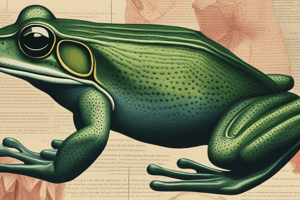Podcast
Questions and Answers
What are the characteristics of frogs?
What are the characteristics of frogs?
- They have separate sexes. (correct)
- They reproduce through internal fertilization.
- They are chordates. (correct)
- They are reptiles.
What is the primary function of hindlimbs in frogs?
What is the primary function of hindlimbs in frogs?
Aid in swimming, climbing, and jumping.
What do forelimbs in frogs assist with?
What do forelimbs in frogs assist with?
Gripping surfaces during locomotion.
What are digits?
What are digits?
What is the function of a frog's tongue?
What is the function of a frog's tongue?
What is the maxilla?
What is the maxilla?
What does the mandible refer to?
What does the mandible refer to?
What are vomerine teeth?
What are vomerine teeth?
What is the function of maxillary teeth?
What is the function of maxillary teeth?
What role does the esophagus play in a frog's feeding?
What role does the esophagus play in a frog's feeding?
What is the function of the nictitating membrane?
What is the function of the nictitating membrane?
What does the tympanic membrane do?
What does the tympanic membrane do?
What is the epidermis?
What is the epidermis?
What is the function of lungs in frogs?
What is the function of lungs in frogs?
How is gas taken in by frogs?
How is gas taken in by frogs?
What happens at the internal nares?
What happens at the internal nares?
What is the function of the glottis?
What is the function of the glottis?
What is the cloacal opening?
What is the cloacal opening?
Flashcards are hidden until you start studying
Study Notes
External Anatomy of Frog
- Frogs are chordates and amphibians, exhibiting a diet that can include filter feeding or carnivorous habits, with separate sexes and external fertilization.
Limbs and Digits
- Hindlimbs are crucial for swimming, climbing, and jumping, enhancing the frog's movement capabilities.
- Forelimbs aid in gripping surfaces during locomotion, providing stability and control.
- Digits found on both the fore and hindlimbs; hindlimb digits have modified webbing, facilitating swimming.
Feeding Mechanisms
- The tongue's length and stickiness are specially adapted for capturing insects, an essential feeding strategy.
- Maxilla refers to the upper jaw, playing a vital role in the feeding process.
- Mandible denotes the lower jaw, working in conjunction with the maxilla.
- Vomerine teeth are situated on the maxilla, preventing food from escaping during consumption.
- Maxillary teeth are located on the outer ridge of the maxilla, further ensuring food retention.
- The esophagus serves as a large horizontal passage at the back of the mouth, enabling the swallowing of food.
Sensory and Protective Features
- The nicitating membrane is a transparent skin flap that protects the eye while the frog is underwater.
- The typanic membrane detects sound waves, enhancing communication and environmental awareness.
Respiratory System
- The epidermis, or skin, plays a role in respiration, allowing gas exchange.
- Lungs facilitate the exchange of gases, crucial for survival.
- External nares are nostrils through which gas is inhaled.
- Internal nares connect gas from external nares to the mouth cavity.
- The glottis is a passage for air from the mouth to the lungs.
Excretion
- The cloacal opening is the exit point for undigested food, urine, eggs, and sperm, indicating a multifunctional role in excretion.
Studying That Suits You
Use AI to generate personalized quizzes and flashcards to suit your learning preferences.




